|
|
|
|
|
|
|
|
|
 Posted: Thu Nov 03, 2011 8:31 am Posted: Thu Nov 03, 2011 8:31 am
I will post a picture and some information, please don't spam the thread, if you have a question please make a thread in this subforum or send me a pm.
List will be in alphabetical order and I will only cover purebreds.
All credit goes to these sites.
http://www.messybeast.com/breeds.htm
http://www.cat-breed-info.com/complete-list-of-cat-breeds.html
|
 |
 |
|
|
|
|
|
|
|
|
|
|
|
|
 Posted: Thu Nov 03, 2011 8:46 am Posted: Thu Nov 03, 2011 8:46 am
Abyssinian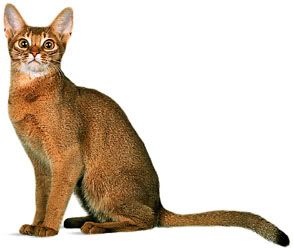 Status: Status: Current HistoryThe Abyssinian cat breed is one of the oldest breeds of domesticated cats but little is known about its real origins. Some think that it is a descendant of the first cats of Egypt as the Abyssinian looks like the cats in Egyptian art and some believe that British soldiers brought a cat from Abyssinia (now known as Ethiopia) with them at the end of the Abyssinian war in 1868. An Abyssinian took third prize at the Crystal Palace cat show of 1871 and in 1889 the founder of the cat fancy, Harrison Weir, wrote a breed standard for the Abyssinian cat breed. This cat breed was further developed in Britain from 1896 and the first Abyssinian arrived in the USA in the early 1900’s. In the 1930’s the breed was even further developed and it became one of the favorite breeds of cat in the USA. Description The Abyssinian cat breed looks like a small mountain lion with an expressive face and a ticked coat that shimmers. These cats are athletic, very active and graceful. The Abyssinian is a short-haired cat with a coat that has a warm color produced by the Agouti ticking. This means that each shaft of hair has bands of alternating color. The coat comes in cinnamon, blue, ruddy, chocolate, lilac and fawn colors. The ticked pattern is a dominant tabby gene and the first color recognized in the breed was a brown tabby. The head is a modified wedge shape with large ears that arch forward. The Abyssinian’s eyes are large and can be gold, amber or green with a dark ring around it. The Abyssinian is medium sized with a graceful and muscular body. They appear to stand on tiptoe, but that is due to the slim long legs with oval-shaped feet. A typical male Abyssinian weighs 8-10 pounds with the female weighing 6-7 pounds Personality & TemperamentDo not consider this cat breed to be a lap cat as they are extremely active and love to explore their surroundings. They like to sit up on a high perch to watch comings and goings and are very curious about what is going on. The Abyssinian is highly intelligent and likes to interact with its owners. They are a playful breed of cat that likes to play games that involve lots of jumping and running. Health IssuesThe Abyssinian cat breed is low-maintenance, but there are some health issues that good breeders should be aware of and should be able to inform you about. A private kinase deficiency causing intermittent anemia is carried as a recessive trait but there is a genetic test available for this. Patellar luxation or slipping kneecaps, retinal atrophy and renal amyloidosis (deposits in the kidneys) may also be found.
|
 |
 |
|
|
|
|
|
|
|
|
|
|
|
|
|
|
|
 Posted: Thu Nov 03, 2011 8:53 am Posted: Thu Nov 03, 2011 8:53 am
American Bobtail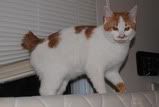 Status: Status: Current HistoryThe development of the American Bobtail cat breed began only in the late 1960’s. A young couple, John and Brenda Sanders were driving through an Indian Reservation in Arizona when they came upon a kitten with a short tail. They took this kitten home and named him Yodi. When Yodi and the Sanders non-pedigree domestic cat mated, the kittens all had Yodi’s unusual short tail. Charlotte Bentley and Mindi Shultz, who were friends of the young couple, saw the potential of a new cat breed. The first true American Bobtails were produced by them when they out-crossed the bobtail kittens with a long-haired color point cat. TICA recognized the breed as a naturally occurring cat breed in 1989. Feral bobtailed cats were the foundation stock of this breed, but most breeders do not use feral cats anymore. DescriptionThe American Bobtail is a medium to large sized cat that is native to North America. This short-tailed cat is well-muscled and solid, but is graceful and athletic. The short bobtail is the cat’s most distinguishing feature and no two tails are the same. As the name suggests, the most unusual trait is the cat's shortened tail. Breed standards require the tail to be a minimum of one inch in length and not longer than the hock. Each kitten in a litter will have a different tail length as the mutation gene responsible for the short tail is not controllable. This cat breed literally comes in any color and pattern ranging from chocolate, black, brown, blue, lilac, red, cream, cinnamon and fawn. There are two hair lengths – short hair and long hair. The short hair variety is thick and plush and requires a brushing once a week. The long haired coat requires a grooming session twice a week to keep it from becoming dull. Adult males weigh between 12-16 pounds and adult females weigh between 7-11 pounds. Personality & TemperamentThis cat breed will form a strong bond with the entire family and gets along well with other pets and children. These cats do not like being on their own and are very affectionate, however, they are not a cat that will be in your face all the time. Although they are active, they are not constantly in motion. They can be taught to play fetch and to walk on a leash. Health IssuesThe American Bobtail cat breed is a very hardy breed with few known health issues, however, speak to the breeder as he/she should be able to inform you of any problems that might have come up in the past.
|
 |
 |
|
|
|
|
|
|
|
|
|
|
|
|
 Posted: Thu Nov 03, 2011 8:58 am Posted: Thu Nov 03, 2011 8:58 am
American Curl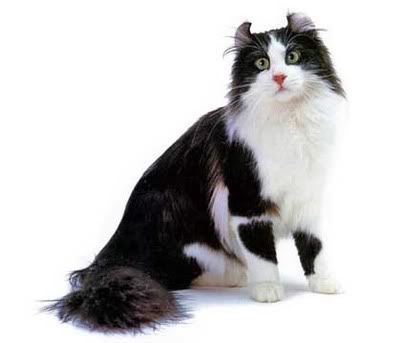 Status: Status: Current HistoryThe American Curl cat’s history begins in June 1981 in California, where Joe and Grace Ruga found a stray kitten that had long, silky hair. What was unusual about this kitten was its ears – the tips were curled backwards. This kitten was called Shulamith and all American Curl cats can be traced back to her. Shulamith had her first litter of kitten in December 1981 and two of the kittens had the same curly ears. During 1983 cat fanciers started to develop a selective breeding program to conserve the curly ear gene and to develop a breed based on this gene. Renowned English feline geneticist, Roy Robinson analyzed data from 383 kittens from 81 litters, and working with breeders, confirmed that the curly ear gene was unique and an autosomal dominant gene. This meant that any cat that has even one copy of this gene will have the curly ears. The foundation for a new breed of cat was established when Roy Robinson published an article in the Journal of Heredity in December 1989. He stated that he found no defects in any of the crossed analyzed. DescriptionThe American Curl is a native breed to America and is a medium-sized cat. The ears curl out and backwards making the cat look alert with a happy expression. he coat of the American Curl comes in either short-hair or longhair varieties. There is little undercoat which means that very little grooming is required. Coat colors are varied – from black through to mackerel tabby. The ears are the main feature of this cat breed, but the large walnut shaped eyes are another distinguishing feature. This cat breed is medium-sized with a rounded head. They are elegant looking cats with an open facial expression. The longhair variety has a silky, shiny plumed tail. When an American Curl is born, it has straight ears. The ears start to gently unfold after about 3-5 days and at 16 weeks, the ears reach the final shape. The degree of the curl varies greatly. To maintain genetic diversity, breeders out-cross breeding with cats that do not have curled ears. Half of these out-crosses will have curled ears. The curly ear gene affects the cartilage of the ear and should be firm to the touch.
Personality & TemperamentThis friendly cat breed is very people-orientated and wants to be in your company constantly. They get along well with children and other pets. This intelligent and curious cat is not overly talkative, but makes soft cooing sounds to attract your attention. The American Curl cat will remain kitten-like throughout its life - always looking for an opportunity to play. You will find this cat wherever you are and he will insist on helping you with your tasks!
Health IssuesThe American Curl is a robust, healthy cat breed with no breed-specific problems.
|
 |
 |
|
|
|
|
|
|
|
|
|
|
|
|
|
|
|
 Posted: Thu Nov 03, 2011 9:03 am Posted: Thu Nov 03, 2011 9:03 am
American Shorthair 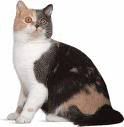 Status: Status: Current HistoryThe first American Shorthair cat breeds were strong, hardy cats that were used on ships to protect food supply rooms from rats and mice. In the 1900’s in cat exhibitions, shorthair cats were known as Domestic Shorthairs, but when a silver classic tabby won the title of Cat of the Year, the name was changed to American Shorthair. Although the American Shorthair is a natural cat breed, selective breeding programs developed this breed into one of America’s favorite cat breeds. In the early 1960’s after the breed was renamed to the American Shorthair this cat breed started to make a name for itself at cat shows.
DescriptionThe American Shorthair cat breed is a medium sized cat. The body is firm and muscular. As the name suggests, the hair is short and comes in a variety of colors and patterns – almost any color that you can imagine. The head is longer rather than wider with eyes that are wide-set and rounded in shape. The ears are also slightly rounded at the tip. A number of different looks are accepted by TICA for this breed of cat. The males are larger than the females. The coat is short and the color of the cat affects the texture of the coat, which can be hard or soft in texture but is silky and lustrous. The coat does not require a lot of grooming, a brushing once a week to remove loose hair is all that is required. Personality & TemperamentThe American Shorthair cat breed is a very popular cat breed, especially with families as they are very tolerant of children. They are loyal, easy-going and take things in their stride. The American Shorthair is intelligent, playful and curious – they like to “help” with whatever you are busy with. Although they are loyal and affectionate, they are not overly demanding – they generally choose when they want to sit on your lap. This cat breed is the perfect companion for every kind of person as they tend to adapt to their people and their surroundings. The American Shorthair is perfect for families with children or for elderly people who do not want an over-active cat. They are suited to living in a big house or in a smaller apartment. Health IssuesThe American Shorthair cat is a strong, sturdy cat with virtually no known health issues.
|
 |
 |
|
|
|
|
|
|
|
|
|
|
|
|
 Posted: Thu Nov 03, 2011 9:08 am Posted: Thu Nov 03, 2011 9:08 am
American Wirehair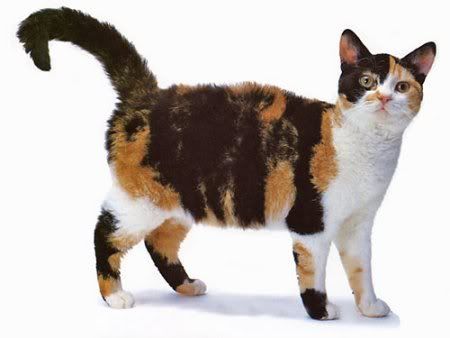 Status: Status: Current HistoryThe first American Wirehair cat breed came from a litter of 6 kittens born in Verona, New York. The kitten had a short, wiry coat and even his whiskers were crimped. The litter’s parents were normal domestic shorthairs. A local cat breeder by the name of Joan O’Shea who saw the kitten, realized that he was unique and bought him from the farm owner, Nathan Mosher. Joan O’Shea bred this wiry-hair male with a domestic shorthair female and this mating produced kittens with wiry coats. Another breeding to a completely unrelated female also produced wiry-haired kittens and so established it as a dominant gene. Roy Robinson and A.G. Searle (cat geneticists) analyzed cat hair samples sent to them by Joan O’Shea and replied to her that the coat was unique and not related to the Cornish or Devon Rex cat breeds. The American Shorthair cat breed was used to further develop the American Wirehair cat DescriptionThe American Wirehair cat breed is a medium sized cat with a muscular and firm body. The head is longer rather than wider and the eyes are a rounded shape. The ears are slightly rounded at the tip. Females of this cat breed are smaller than the males. What makes the American Wirehair stand out from its other shorthair counterparts is the wiry coat. The coat comes in all color and patterns, but the wiriness of the hair has several degrees to it. It can range from spiked to curly with individual hairs being hooked, bent or crimped. The coat should ideally be dense, coarse and crimped over the entire body, the same goes for the whiskers. This cat breed’s coat is soft to the touch and springs back into place when ruffled. Some American Wirehair cats are prone to skin allergies and the skin and coat should be kept dry and clean to avoid any problems. Regular bathing is recommended to remove any loose hair that could cause irritation.
Personality & TemperamentThe American Wirehair enjoys human company, but is not a demanding cat and remains independent. They are tolerant of children and other pets and are loyal and playful. Health IssuesAlthought the American Wirehair coat is low maintenance, this different cat breed is prone to skin allergies and a heavy build-up of earwax. Regular cleaning and bathing is therefore essential to keep this unusual cat in perfect condition.
|
 |
 |
|
|
|
|
|
|
|
|
|
|
|
|
|
|
|
 Posted: Thu Nov 03, 2011 9:32 am Posted: Thu Nov 03, 2011 9:32 am
Balinese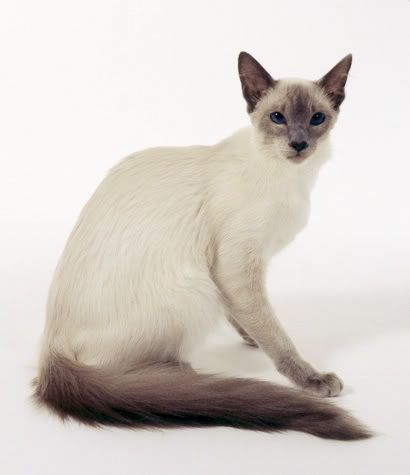 History HistoryEarly references appear of the Balinese cat breed, but little is known about the history of the Balinese. In 1871 reference is made to a long haired Siamese and there is a CFF (Cat Fanciers Federation) registration record in 1928 for a long haired Siamese. The actual breeding history of the Balinese starts with the first breeding programs in the 1950’s. Marion Dorsey from California and Helen Smith from New York were both Siamese breeders who decided to develop the long haired Siamese kittens that were appearing in their Siamese litters. The name Balinese is a reference to the graceful Balinese dancers that Helen Smith admires. Originally, the Balinese cat breed was recognized in four colors – chocolate, lilac, blue and seal. Red, cream and tabby patterns were added in 1979 and more recently, all these colors in combination with white were accepted. The Balinese was recognized for competition in 1979 by TICA.
DescriptionThe Balinese is a graceful, muscular and elegant cat. This cat breed has a long and silky coat that goes beautifully with its regal bearing. The single coat lies close to the body and lacks an undercoat, which makes grooming easy as there is no matting. The tail is plumed and the hair on the tail can be up to 5 inches long. The Balinese have sapphire blue eyes and the pointed pattern coloring is restricted to the face, the legs, the tail and the ears. The body is a creamy white. The Balinese has a svelte body type with long legs. Even though it is an elegant and fine-boned cat, the Balinese is all muscle. The females weigh from 5-7 pounds and the males weigh from 6-8 pounds. Despite its long hair, the Balinese cat breed is easy to groom. The coat does not tangle or mat and a brushing is all that is needed to remove any loose hair. The Javanese cat breed is an offshoot breed from the Balinese. As the CFA (Cat Fanciers Association) only accepts four colors (seal, chocolate, blue and lilac) in the Balinese, it classifies all other colors under the Javanese cat breed.
Personality & TemperamentThe Balinese is an extremely loyal and people-orientated cat breed that gets along well with children and other pets. If you are looking for a vocal cat that will have a “conversation” with you, then the Balinese is the cat breed for you. Because the Balinese is such an intelligent, active and people-orientated cat, you will have to engage your cat in high-activity games. These cats do not do well on their own for long periods of time. Rather get a companion cat if you need to leave your Balinese alone. Health IssuesThe Balinese cat breed is a long-lived, robust cat breed with no known health issues.
|
 |
 |
|
|
|
|
|
|
|
|
|
|
|
|
 Posted: Thu Nov 03, 2011 9:39 am Posted: Thu Nov 03, 2011 9:39 am
Bengal History HistoryThe Bengal cat breed is a perfect example of man’s need to breed a domestic cat that has the look of a wild jungle cat. In the 1960's, there was an accidental mating between and Asian Leopard Cat and a black, shorthaired domestic cat at Jean Sugden's home in California. She made no further attempt to develop this hybrid cat breed until the early 1970's when she (now Jean Mill) received more such hybrids from Dr Willard Centerwall at the University of California. These cats were part of a research project aimed at determining if the Leopard Cat's immunity to feline leukemia could be transferred to domestic cats. Unfortunately results were negative. This was the first effort to create a cat breed with the temperament of the house cat and the look of a jungle cat. The Bengal cat breed of today can be traced back to cats bred by Jean S. Mill in the early 1980’s. In 1986 TICA accepted the Bengal as a new breed and in 1991 this cat breed received championship status in 1991. The modern domestic Bengal cat comes only from breeding Bengals to other Bengal cats. DescriptionOriginally there was just a spotted coat type, but over time variations appeared and different associations have different standards for the Bengal cat breed. The Bengal cat is a medium to large sized cat with a magnificently colored coat that has vivid spots or distinctive marbling. A feature called glitter is found in some Bengal’s coats and it is this feature that gives the iridescent sheen to each hair. The spots on the Bengal’s coat can be small or large and often have a two-toned look. A swirling pattern that appears as random swirls or flowing horizontal lines is referred to as the marble pattern. The most popular coat color is brown or black tabby, which can be anything from shades of golden, copper, bronze, gray or mahogany with spots or marbling. Spots and marbling can be intense black or rich brown. Snow Bengals have a recessive pointed gene that result in blue eyes and a cream base coat with a pearly shimmer. Silver Bengals have a coat with a white or gray background with dark gray to black patterns. Bengal males are generally larger than the females and weight ranges from 6-15 pounds. The Bengal cat breed is well muscled and has an athletic look.
Personality & TemperamentA clear understanding is needed of what exactly is meant by a Bengal. The Bengal name can only really be applied to F4 hybrids - cats that are four generations down from the wild cross. Cats from earlier generations (foundation cats) are much closer to their wild ancestors and find domestic life very difficult. They are ofthen nervous and do not integrate well into famliy life with people and other pets. F4 Bengals tend to be inquisitive, confident and active cats that can be found high up on a perch, generally looking for something to do. They are affectionate and devoted and get along well with other pets when properly integrated. The Bengal cat breed needs lots of playtime that involves running, chasing, climbing and jumping. Bengals like to play in water and will even try to join you in the bath. Some use their voices to talk to you whilst others are quiet cats. Do not expect a docile lap cat when you get a Bengal. This cat is all about action and fun. Should you consider a cat breed like the Bengal, first find out as much as you can from a registered breeder. Health IssuesThe Bengal cat breed is very prone to Irritable Bowel Syndrome, most likely due to their wild heritage. The cereal content in commercial cat foods can aggravate this condition and you will have to spend the time and the money to find the right food for your Bengal. You will have to boil drinking water for a Bengal cat as they are also susceptible to micro-organisms found in unchlorinated water.
|
 |
 |
|
|
|
|
|
|
|
|
|
|
|
|
|
|
|
 Posted: Thu Nov 03, 2011 9:55 am Posted: Thu Nov 03, 2011 9:55 am
Birman History HistoryThere is a legend around the Birman cat breed which tells of the Birman being raised by Kittah priests in their temple in Burma (now Myanmar). The temple had a golden statue of a goddess who presided over the passage of souls. The statue had sapphires for eyes. In this temple a hundred pure white cats lived and when a priest died, his soul would enter the body of one of the cats. When the cat died, the priest would be reborn. One of these cats was called Sinh, and he was the companion of the head priest, Mun-Ha. Mun-Ha was gravely injured in an attack on the temple and as he lay dying, Sinh leapt onto his body. Sinh stared at the statue and his coat took on the golden hues of the statue and the brown shades of the earth, only his paws that were touching his master remained white. His eyes turned sapphire blue. Sinh stayed on Mun-Ha's body for seven days, refusing to eat, until he himself died. Seven days later as the priests assembled to decide who would be Mun-Ha's successor, all the other temple cats walked in, all transformed as Sinh had been. They surrounded the youngest of the priests and he was declared the new head priest. The real history of how the Birman cat breed came to Europe is not quite clear. The most popular of two stories is that two Europeans, August Pavie and Major Gordon Russel were given two cats for saving a temple. The male cat died on their way to France, but the female called Sita, was pregnant and founded the breed in Europe. The time lines to this story do not make sense though. The two Europeans were in Asia in 1898 but the cats were only sent to France in 1919 - a time gap of two decades seems impossible. The other story says that two cats were stolen and given to an American millionaire who then passed them on to Mme Thadde Hadisch. Again, the male died and the female named Sita gave birth to kittens after arriving in France in 1920. All that is really certain is that a cat breed named Sacre de Birmanie (the Sacred Cat of Burma) was registered in France in 1925. The breed almost died out during World War II but fortunately outcrossing to appropriate breeds was undertaken and during the 1960's the breed was accepted on both sides of the Atlantic. DescriptionThe Birman cat breed is a medium to large sized cat with a stocky build. It has distinctive white gloves on the feet and the back feet have laces extending halfway up the back leg. This gorgeous cat’s coat is longhaired and pointed and is soft and silky. The thickness of the coat varies from season to season. The coat does not mat, but it still needs regular care to ensure that it remains tangle-free and silky. Birmans come in all pointed colors. (Same color body with the tail, face, paws and ears another color.) The ears of the Birman cat breed are almost as wide as they are tall and the eyes are medium to large and round. The tail is in balance with the body which is long and sturdy. The legs are well muscled and in proportion with the body.
Personality & TemperamentThe Birman makes a perfect family pet that gets along well with children and other pets and they are just as happy in a single cat/pet household. The beautiful Birman is talkative when people respond to the meowing and cooing sounds it makes, but if you do not respond, the cat will soon stop talking to you. This cat is an active and playful cat that needs lots of stimulation through games in order not to become bored. The Birman makes a great lap cat as it loves to snuggle on your lap for a mutual cuddle.
Health IssuesThe Birman cat breed is fairly healthy and there are no major hereditary disorders. Speak to the breeders as they should also be able to inform you of any health issues that they have come across.
|
 |
 |
|
|
|
|
|
|
|
|
|
|
|
|
 Posted: Thu Nov 03, 2011 10:00 am Posted: Thu Nov 03, 2011 10:00 am
Bombay History HistoryNikki Horner started to develop the Bombay cat breed in 1953 from combining black American Shorthairs with Burmese cats. She wanted a cat breed with a dark black coat and bright copper penny eyes. Early efforts were unsuccessful and in 1965 she finally found a winning breed combination. In 1970 when the breed was accepted for championship competitions, Nikki Horner stopped breeding cats, but other breeders worked to keep the breed alive. Herb and Suzanne Zwecker were two people who had a major influence on the Bombay cat breed’s development and progression. They developed new lines and in 1979, TICA accepted the Bombay for championship competitions. DescriptionTo get an idea of the look of the Bombay, just think of a small version of the Black Panther. The Bombay cat comes in one color only – black. Imagine the deepest, darkest, midnight black you can and you will have an idea of the color of this cat’s coat. The tight, short coat has a shiny, glossy sheen to it that makes grooming easy. A brushing once a week to remove loose hair is all that is needed to keep the coat in top condition. This cat breed is medium sized and well muscled. The ears are medium sized and set well apart. The head is rounded with large wide-set eyes. The Bombay cat’s eyes can be rich gold or copper colored and makes for a stunning contrast to the black coat. The Bombay breed standards call for brilliant copper eyes but as this is a very hard color to achieve, gold is accepted as well. Personality & TemperamentThe Bombay is an easy-going, inquisitive and loving cat that loves to play and play some more. They are very people-orientated and will greet you and any visitors at the door. This cat breed simply loves to be around people and does not do well on its own. You should consider getting a companion cat if you are going to be leaving your Bombay alone for long periods of time. If properly integrated, the Bombay cat gets along well with other pets such as dogs and because of its loving nature, is the perfect cat to have with children.
Health IssuesThe Bombay cat and the Burmese are closely related and share the same health and genetic problems. These two cat breeds have the same head and body type. Some of the main health issues of the Bombay cat include cranial deformities, breathing problems and excessive eye tearing due to the foreshortened nose.
|
 |
 |
|
|
|
|
|
|
|
|
|
|
|
|
|
|
|
 Posted: Thu Nov 03, 2011 10:07 am Posted: Thu Nov 03, 2011 10:07 am
British Shorthair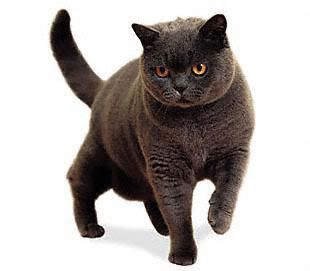 History HistoryThe British Shorthair was one of the first breeds of the cat fancy and their origins can be traced back to cats that were imported from Egypt with Romans when they invaded Great Britain. The founder of the cat fancy, Harrison Weir bred these cats and in particular British Blues. This robust cat breed was one of the most popular cat breeds at the early shows. Between 1914 and 1918 cross-breeding was done with Persians and the longhair gene was introduced. The shorthair cats were part of their own breeding programs whilst the longhair cats were made part of the Persian breeding programs. The Governing Council of the Cat Fancy declared after WW I that only 3rd generation offspring of the British Shorthair / Persian crosses could be shown, with the result that breeding stock drastically reduced. The shorthair breeding lines were doomed to be lost after WW II, but a couple of breeders got together and crossed the British Shorthair with domestic shorthairs, Russian Blues and Persians. By the 1970's, the British Shorthair cat breed was almost back to its former glory. In June 1979, the British Shorthair achieved championship status with TICA. The longhair version of this cat breed only obtained championship status with TICA in May 2009. Description(The description below is valid for both the shorthair and the longhair breeds, the only obvious difference is the length of the hair.) This cat breed is medium to large sized with a powerful, compact build. The chest is broad and the legs are short but strong. The tail is also short but quite thick with a rounded tip. The coat is dense and plush – almost like a luxurious pile carpet. The eyes are large and round and can be a copper to a deep gold color. The classic blue color remains the most popular for this breed, but there is almost no limit to the range of colors available. These cats have round heads with short noses and chubby cheeks. The prominent rounded whisker pads give the cat a permanent smile. Grooming is easy where the shorthair breed is concerned. The coat does not tangle, so a weekly brushing is enough to keep the coat is perfect condition. The British Longhair needs a daily grooming session as the hair tangles and mats easily. A bath is required regularly to keep the longhair coat in top condition. Both the shorthair and the longhair breeds are solid cats that can weigh from 9-18 pounds. As these cats are sedentary, care should be taken to prevent them from becoming overweight. Personality & TemperamentThese cats are affectionate but undemanding. They are loyal and devoted but don't expect them to be lap cats and don't expect them to like being carried around. Both breeds are tolerant of children and other pets, but are quite content to amuse themselves whilst alone. The males of this breed seem to be friendlier and more affectionate than the quiet and unobtrusive females. You should spent time playing with these cats as they have a natural tendency to become overweight. Toys that get them running and jumping provide the necessary activity and exercise. Health IssuesThe robust and chunky cat breed has a tendency to become overweight. You can prevent this by following the feeding instruction closely on the cat food packaging. No serious health issues are known of, but there is one medical oddity - the blood type B is very rare in the British moggie but it is the blood type of around 40% of all British Shorthair cats.
|
 |
 |
|
|
|
|
|
|
|
|
|
|
|
|
 Posted: Thu Nov 03, 2011 10:12 am Posted: Thu Nov 03, 2011 10:12 am
Burmese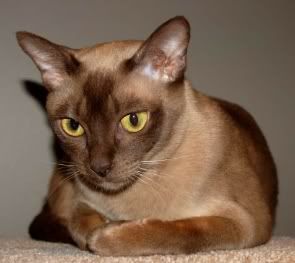 History HistoryThe first record of a Burmese cat was found in 1930 when a sailor brought a cat from the Orient and gave her to Dr Joseph G. Thompson in San Francisco. This cats name was Wong Mau and the Burmese cat breed was developed from her. Wong Mau was walnut brown with darker brown points. Some breeders thought she was a dark Siamese but Dr Thompson established a breeding program to reproduce her distinguishing features. In 1932, she was bred to Tai Mau, a Seal Point Siamese. This mating resulted in kittens with two colors some like Wong Mau and the other like Siamese. Wong Mau was bred to one of her sons and the breeding resulted in kittens with 3 distinct colors some like Siamese, some like Wong Mau and some dark brown. It was the dark brown offspring that founded the Burmese breed as we know it today. The first blue Burmese kitten was born in England in March 1955. Most Burmese breeders preferred to breed only the sable cats, although other color variations had made an appearance earlier. The Burmese was one of the original breeds to be recognized by TICA in June 1979. The European Burmese was originally the same as the American Burmese and all Burmese cats trace their history back to Wong Mau. In 1952 the breed was officially recognized in the UK in the original brown color. From there, the Burmese cat breed diverged into two completely different looks - one in the USA and one in Europe. The European cats had more colors and eventually the differences in the head shape as well as the health issues led to the American Burmese being banned from European breeding programs. DescriptionThe Burmese cat breed is a medium sized cat with a strong, well muscled and compact body. The coat is short, silky and shiny and does not require much grooming other than a weekly brushing to remove loose hair. The head is round with large golden eyes. In young Burmese cats, the points will be darker and as the cat matures, the color will become deeper and richer. In older cats there is little difference in color between the body and the legs, head and tail. A range of tortoiseshell and solid colors are available dark sable brown, a medium warm blue, a lilac that can be bright pink-gray to silver-platinum, a warm honey beige chocolate with fawn tints, reds with a tint of golden apricot and deep creams with a tint of golden apricot. Personality & TemperamentThe Burmese cat breed is a people-orientated cat that loves to curl up on a lap. They are very social and playful cats and are very tolerant of children and other pets. If you are going to be leaving your Burmese alone for long periods, you have to get a companion as the Burmese does not do well on its own. This cat has a soft, sweet voice and likes to engage people in a conversation.
Health IssuesThe Burmese cat is generally sound in health but the American Burmese carry a lethal gene called the Burmese head fault or craniofacial defect. Kittens born with this defect have one lower jaw but two upper muzzles and noses. The eyes and ears are also deformed and the top of the head is incomplete. Survival is impossible and kittens often die at birth or are euthanized immediately. A cat by the name of Good Fortune Fortunatus appeared in the pedigrees of many American Burmese but he carried the lethal genetic deformity leading to the American bloodlines often being banned to try and avoid this lethal gene. Geneticists have identified the chromosome that is responsible for the deformity and hope that they will soon be able to find the gene and develop genetic testing so that the deadly fault can be bred out.
|
 |
 |
|
|
|
|
|
|
|
|
|
|
|
|
|
|
|
 Posted: Thu Nov 03, 2011 10:23 am Posted: Thu Nov 03, 2011 10:23 am
Chartreux Status: Status: Current HistoryLegend has it that the Chartreux cat breed is descended from cats brought to France by Carthusian monks. The monastery was located in the Chartreuse Mountains north of the city of Grenoble. No records have ever been found of any such cats living at the monastery. Another story about the origins of this different cat breed is that Chartreux cats were brought to France from Syria in the 13th century by returning crusaders. Most of these crusaders became Carthusian monks. References to grey cats with a sturdy build and copper eyes known as 'the cats of Syria' are found in 16th century French sources. However, it is more likely that the name of this cat came from a Spanish woollen fabric called 'pile de Chartreux'. Chartreux cats could be found living in small colonies all over France and on Belle Ile, off the coast of Brittany. The first documented mention of this cat breed was by French naturalist Buffon in the 18th century. An effort by European breeders kept the breed from extinction after its numbers dwindled drastically after WW I and WW II. Helen and John Gammon brought the first cats of this breed to the USA in 1971 and in 1987, this cat breed was awarded championship status by the Cat Fanciers Association. Another name for this cat breed is the Chartreuse cat.
DescriptionThis large cat breed is muscular with short limbs and big paws. The head is rounded with a long, tapered muzzle. This gives them a smiling expression. The Chartreux cat's coat is a soft plush of even blue with a silver sheen. Their eyes range from deepest copper to different shades of gold. The coat length is short with a dense undercoat and a protective topcoat. Regular grooming is needed to maintain the coat’s condition and to remove loose hair from the dense undercoat. The best way to keep the coat in good condition is to rub and stroke the coat with a soft cloth or a grooming glove. Personality & TemperamentChartreux cats are a quiet cat breed that rarely makes a sound, this might be why they are considered to be some of the cat world’s best hunters. They are intelligent and learn new things very quickly. These cats are very playful and can be taught to play fetch. They are good with children and other pets but tend to bond strongly with one specific person in the household. Despite this, they are still affectionate and loving towards other family members. Health IssuesThe Chartreux cat breed is a healthy and robust cat breed. There is one health concern though - slipping kneecaps (patellar luxation). Speak to the breeder as they should have screened for this condition.
|
 |
 |
|
|
|
|
|
|
|
|
 |
|
|
|
|
|
|













